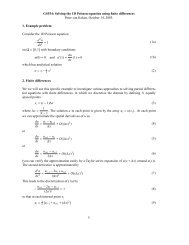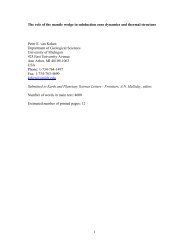Quantitative paleoenvironmental and paleoclimatic reconstruction ...
Quantitative paleoenvironmental and paleoclimatic reconstruction ...
Quantitative paleoenvironmental and paleoclimatic reconstruction ...
You also want an ePaper? Increase the reach of your titles
YUMPU automatically turns print PDFs into web optimized ePapers that Google loves.
ARTICLE IN PRESS<br />
22 N.D. Sheldon, N.J. Tabor / Earth-Science Reviews xxx (2009) xxx–xxx<br />
Fig. 13. Multi-equation thermodynamically-derived profile versus mass-balance calculations.<br />
counterparts. Therefore, these results are suggestive that the middle<br />
Miocene warm event was due, at least in part, to elevated atmospheric<br />
pCO 2 (Sheldon, 2006b).<br />
The multi-equation thermodynamic approach thus potentially<br />
gives a wide range of information about both pedogenic environment<br />
<strong>and</strong> the climatic conditions under which the modeled paleosol(s)<br />
formed. Potential limitations include poorly constrained parent<br />
material chemistry <strong>and</strong> poorly constrained vegetative covering.<br />
However, in areas where both are known (e.g., paleosols formed on<br />
volcanic units or at unconformities with associated floras or clear<br />
taxonomic identifications), this approach is viable. Furthermore, for<br />
pre-vascular l<strong>and</strong> plant paleosols, it presents an excellent potential<br />
research tool because one of the two primary limitations is removed.<br />
7. Stable isotope approaches<br />
7.1. Stable isotopic composition of pedogenic minerals as <strong>paleoenvironmental</strong><br />
proxies<br />
The stable isotope values of pedogenically-formed minerals have the<br />
potential to provide <strong>paleoenvironmental</strong> information such as the<br />
isotope composition of soil waters (e.g., Vitali et al., 2002; Tabor <strong>and</strong><br />
Montañez, 2002, 2005; Tabor et al., 2002, 2004a,b), paleotemperature<br />
(Yapp, 1993a, 2000; Delgado <strong>and</strong> Reyes, 1996; Savin <strong>and</strong> Hsieh, 1998;<br />
Vitali et al., 2002; Tabor <strong>and</strong> Montañez, 2005; Gilg, 2003; Tabor, 2007),<br />
the isotope values of gases in the soil (Cerling <strong>and</strong> Quade, 1993; Cerling<br />
et al., 1991; Koch et al., 1995; Yapp, 2001a,b; Fox <strong>and</strong> Koch, 2003;<br />
Behrensmeyer et al., 2007), <strong>and</strong> the partial pressure of soil <strong>and</strong><br />
tropospheric gases (Cerling, 1984; Quade et al., 1989; Cerling, 1991;<br />
Yapp <strong>and</strong> Poths, 1996; Mora et al., 1996; Ekart et al., 1999; Tabor et al.,<br />
2004a,b). The utility of soil authigenic minerals as proxies of<br />
<strong>paleoenvironmental</strong> conditions requires: (1) relatively well-known<br />
temperature-dependent stable-isotope mineral-water fractionation<br />
factors, (2) isotopic equilibrium, or near equilibrium, at the time of<br />
mineral crystallization, (3) closed-system conditions for structurallybound<br />
elements since the time of mineral formation, (4) waterdominated<br />
environments of crystallization, <strong>and</strong> (5) knowledge of the<br />
relationship between the isotope of interest in the mineral <strong>and</strong> the<br />
medium (e.g., H 2 O, CO 2 ) from which it was derived. Considering that the<br />
vast majority of waters on the continents have a meteoric origin, that<br />
processes that govern the global meteoric water line <strong>and</strong> mixing of gases<br />
between the soil <strong>and</strong> atmosphere are similar, <strong>and</strong> the low solubility of<br />
most paleosol minerals, conditions (4) <strong>and</strong> (5) have been likely fulfilled<br />
<strong>and</strong> constant for minerals that form in well-developed soils since at least<br />
the advent of vascular plants during Silurian time (Gregory, 1991; Yapp<br />
<strong>and</strong> Poths, 1991, 1992; Yapp, 2001a,b; Came et al., 2007). Requirements<br />
(1) through (3) are specific to the mineral of interest <strong>and</strong> its paragenesis.<br />
In particular, requirement 1 is critical to drawing <strong>paleoenvironmental</strong><br />
inferences from the stable isotope value of soil minerals.<br />
7.1.1. Mineral-water isotope fractionation <strong>and</strong> the jargon of stable<br />
isotope geochemistry<br />
In this work, we consider variation among stable isotopes of<br />
oxygen, hydrogen <strong>and</strong> carbon in soil media, <strong>and</strong> in solid materials that<br />
occur in paleosol profiles. Herein, we consider the two most abundant<br />
isotopes of oxygen, hydrogen, <strong>and</strong> carbon: 16 O <strong>and</strong> 18 O, 1 H <strong>and</strong> 2 H, 12 C<br />
<strong>and</strong> 13 C. Isotopes of these elements may be partitioned, or fractionate,<br />
differently among the reactants <strong>and</strong> products of chemical reactions. In<br />
general, reactions involving these isotopes are mass-dependent (i.e.,<br />
the process in question discriminates against the higher mass isotope<br />
to some degree). Isotope fractionation is depicted by the chemical<br />
equilibrium constant of a chemical reaction that includes isotope<br />
exchange:<br />
Mineral− 16 O+H 18<br />
2 O X Mineral− 18 O+H 16<br />
2 O: ð44Þ<br />
Please cite this article as: Sheldon, N.D., Tabor, N.J., <strong>Quantitative</strong> <strong>paleoenvironmental</strong> <strong>and</strong> <strong>paleoclimatic</strong> <strong>reconstruction</strong> using paleosols, Earth-<br />
Science Reviews (2009), doi:10.1016/j.earscirev.2009.03.004















